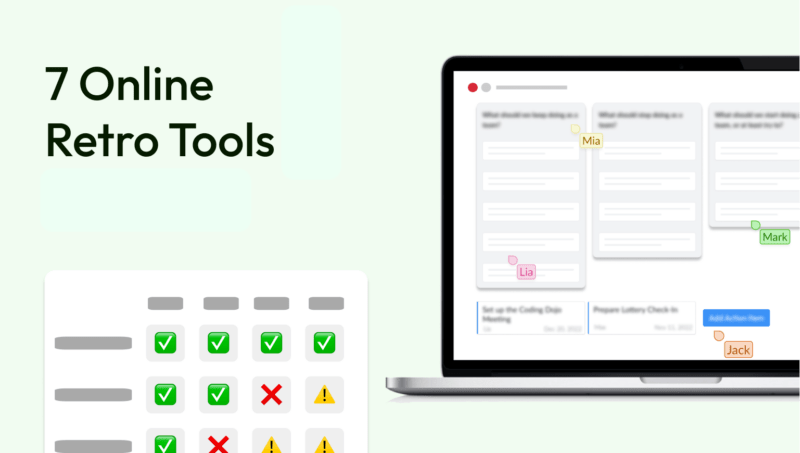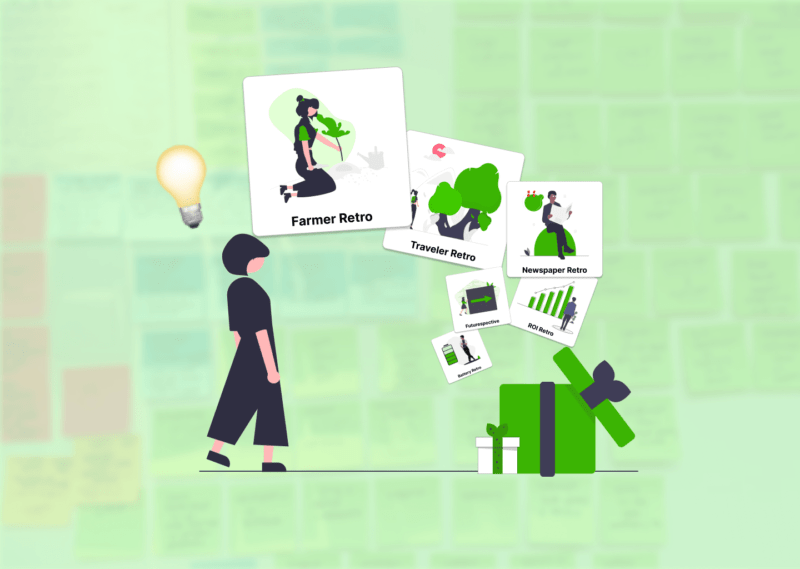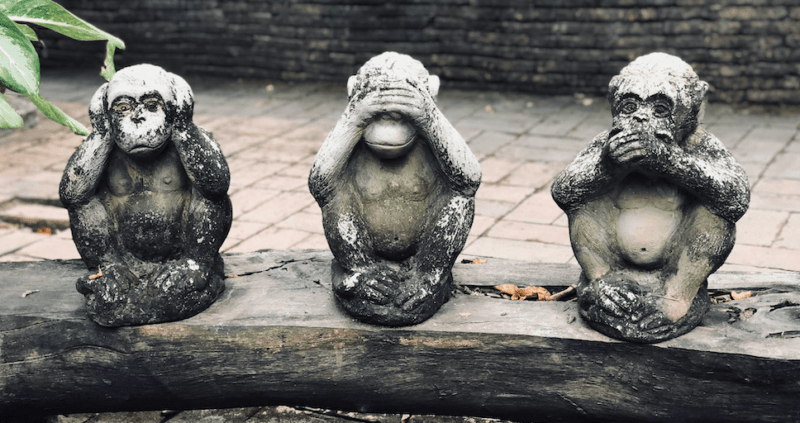Table of Contents
Do you want your boss to love you? Well, then increase the performance of your team! Go from being an average car to being an explosive rocket.
How? Download my free and science based eBook on "Reaching team flow in 12 easy steps" and take is seriously. But now let's get to the actual topic of this text.
There is a lot of talk in retrospectives – but does the team derive good measures from the discussion in the retrospective? Deriving good actions often determines whether retrospectives are perceived by the team as a "chatter meeting", or value-adding time in the team's sprint. They are thus closely related to how much they benefit from agile methods: The agile team and organizational culture.
So in this article, we'd like to share 7 practical tips on how to generate really meaningful action from your retros that will really help your team move forward. And which mistakes you'd better avoid. One thing up front:
If you'd like some more varied questions for your retrospectives, check out our post on that: 54 fresh retrospective methods for beginners and professionals (including the Mario Kart Retro & the Team Morale Health Check).
Tip 1 for good action items in retrospectives: Quality over quantity
The goal of a retrospective is not for every team member to take at least one todo with them. Instead, the goal of a retro should be to develop a common understanding within the team of what the most central issues are for the team.
As the quantity of action items increases, so does the risk that the action item will only be of interest to individuals, but are relatively insignificant for the team as a whole. In such cases, it is less likely that the team will take the time to monitor implementation and effectiveness together. Over time, the measures fall under the table and the feeling arises that the measures from retrospectives are not binding.
The better approach: In your retrospective, aim to identify the top 3 most important issues for which it is worth deriving actions and formulate them in such a way that their implementation actually matters to the team.
Tip 2: In your retrospectives prioritize before defining action items
So how do you manage to increase the quality of action items?
A retrospective consists of different phases with good reason: The 5 phases of a retro. It is no coincidence that the derivation of measures comes at the end. Nevertheless, we too are regularly tempted to think in terms of measures early on in the clarification of feedback and to want to record them.
Defining action items too early in a retrospective can quickly become a problem. Because you do without the important step of first prioritizing the collected feedback and topics. Only after prioritization do you know which topics are most urgent for the team and can form a suitable top 3 priority list.
Therefore, our tip is to record ideas for measures in the first half of the retro as a note WITHOUT already defining a final measure. The definition of measures should only take place after prioritization. Welcome side effect: The consistent rejection of measure discussions in the first half of the retro is also a great benefit for timeboxing.
Tip 3: Only define specific action items (see examples)
Maybe you've heard the same thing: "Well, then let's record as a measure 'Everyone pay attention to being nicer'." No wonder retrospectives are perceived as not adding value when you remain so vague and uncharitable in formulating measures?
If an issue is really important enough to have landed in the top 3 in the prioritization, then you should also make the effort to formulate the measure SMART. Everyone knows it by now and it should be the standard to apply it to the measures from retrospectives as well: The SMART criteria.
For some topics it can be difficult to formulate specific action items. So here are a few examples of Dos and Don'ts when formulating action items:
Don't: | Do instead: |
Everyone makes sure to be nicer to each other. | In the next week: A check-out after each meeting to express appreciation and reflect on our discussion. |
More empathy in video calls | Everyone turns on their cameras next week. |
Better task descriptions | Set up a workshop next week to refresh our “Definition of Ready”. |
Get to the point faster in the daily | Try timeboxing of 2 minutes per person in the Daily until the next retro |
When formulating the action items, it is important to:
- The measures should not be overambitious. You see, for example, that the example is only about "hiring a workshop". So it remains completely open as to what decision will be made in that workshop. The time in the retro should be used to identify the most important issues, not to resolve them immediately. Coordinating a follow-up meeting (called a "breakout session" in our case) can also be a good measure – 10x better than "Better task description" in any case 😉 .
- The measures can also be small experiments: Perhaps not everyone agrees whether the measure bears fruit. Here the rule is: "The proof of the pudding is in the eating". If there are no important reasons against it, formulate the measure in such a way that you only try out a change for the next week, or the next month.
Most Agile Coaches and Scrum Masters run in circles...
...fixing superficial symptoms. Time to use psychology to foster sustainable mindset change.
Tip 4: Define goal and action separately (see examples)
Often the team quickly agrees what the common goal is. The ideas of how this goal should be achieved can of course still vary widely.
Therefore, it is often helpful to first agree on a common goal. Only when a clear goal has been defined should one begin to design possible action items.
In the subsequent review of the measure, the target helps as an anchor to evaluate the effectiveness of a measure. If a goal has been achieved, a measure can be closed. If the measure has been implemented but the goal has not yet been achieved, it might be useful to define a follow-up measure. If a goal has become obsolete due to new conditions, a measure can be discarded – regardless of whether it has already been implemented or not.
In a more structured way, the scheme for the action review could look like this:
| Goal achieved | Goal not achieved | |
| Action item still open | Discard action item | Keep on review for next retro |
| Action item done | Complete the action item | If necessary, plan follow-up actions |
So what can a well-formulated goal for a measure look like? Here are a few suitable examples of measures and associated goals:
| Action item | Goal |
| In the next week: A check-out after each meeting to express appreciation and reflect on our discussion. | Create a more pleasant working atmosphere in discussions |
| Everyone turns on their cameras next week. | Better involvement of all participants in video calls |
| Set up a workshop next week to refresh our “Definition of Ready”. | Fewer queries and fewer waiting times for the implementation of tasks. |
| Try timeboxing of 2 minutes per person in the Daily | Shorter dailies with balanced conversation parts. |
Tip 5: Establish an action item review as a fixed agenda point in your retrospectives
If you are now making the effort to formulate specific action items and the associated goal, then you shouldn't miss the icing on the cake: Establishing a regular review of action items in your sprint cycle.
Personally, I'm surprised that reviewing actions is not (yet) a fixed agenda item for sprint retrospectives in the Scrum Guide. In any case, my recommendation would be to add it here: Scrum Guide.
Depending on the frequency of your retrospectives, it can also make sense to address the review of measures in the team's daily / weekly.
Tip 6: Use timeboxing in retro to create the space needed to define good measures
The retrospective often draws a lot of energy and after 60 minutes of discussion, teams often find it difficult to pull themselves up again and muster the necessary energy to define good measures.
As the moderator of a retrospective, you should therefore keep a close eye on timeboxing and allow sufficient time for deriving measures after prioritizing/voting. 5 minutes at the end of a retrospective are not enough to derive good measures. Especially if team members are already in their heads at the next meeting.
My personal opinion: Avoid retro marathons of 90 minutes or more. I can't blame any team member for not having enough concentration to take good measures after such long meetings. Retros can add great value even in 30, 45 or 60 minutes. At the same time, in my experience, the measures are also better.
Personally, I would always prefer to invest 45 minutes in a retro every two weeks than 90 minutes once a month. Of course, this also has to do with the team's sprint cycle. Maybe your team feels the same way. Ask them – and if you are unsure, give it a try 🙂
I would like to add one thing, regardless of retros: regular 1-to-1 meetings or coaching sessions with your colleagues can have a decisive effect on your team performance. And they can even be data-driven! If you are interested in the topic in more detail, take a look here: Here you will find 129 one-to-one meeting (or appraisal interview) questions and Here are the 3 best one-on-one meeting tools in comparison.
Tip 7: No backlog for action items
"Oh, we still had so many great ideas for action items that didn't make it into the top 3 – should I create a backlog for them?" – No.
Retrospectives always start by soliciting new feedback from the team, and for good reason. So if a topic is really important, it is automatically put back on the agenda of a retrospective via the feedback in the team. In our experience, keeping a separate backlog is counterproductive. In retro, you want to share your new ideas and feedback with the group. At a retro, nobody feels like looking at a long list of past ideas for measures that often have little to do with the team's current challenge.
The rule is: What is important to the team comes back on the agenda of a retrospective through the feedback of the team alone. Retrospectives do not require a backlog for measures.
Tip 8: Reflect on the quality of action items with the team
You should regularly, for example once a quarter, reflect on the quality of action items and retros in general with the team.
Overall, did the action items and retros move you forward? If not, why not? What are the root causes for this (the 5-Why-method is a good choice to go deeper)?
A health check retrospective on this topic can be useful to do so. In health check retrospectives, you ask the team for agreement on a statement (on a scale from 1 to 7). You just need to make sure these statements are precise to get valid feedback from the team.
In our tool (more on this below), for example, it looks something like this. Of course, you can also customize the statements. Have a look – maybe you try it out with your team: Echometer – without login
Note: This retrospective format asks for agreement with the given Health Check items on a scale.
- Improvement: In our team we implement meaningful continuous improvements.
- RO(T)I: The effort and time that we invest in our retros is well invested.
- Focus: The topics discussed in Retro are relevant to everyone and topics that affect only a few are consistently outsourced.
- Process: We manage to implement action items from retrospectives.
Tip 9: Try Echometer
Retro tools are a simple support in deriving good measures. They can relieve you of some of the work – including measures review, timeboxing, but also qualitative derivation of measures. The retro is no longer a monologue but a lively discussion – and you can shine as a moderator
We give you specific hints and appropriate topics for discussion in a sprint retrospective in the tool and how to derive good action items. If you need more information on this, feel free to have a look at our post on "comparing 7 smart retro boards".
You can conduct a retrospective with our tool without anyone having to register by the way ⏫
Simply follow this button to open your first retrospective, choose your retrospective questions and invite the team via link:
Many different methods are possible if you are interested: More than 30 retrospective methods.
If you are still unsure, you can let one of our users convince you here: Holger's (Agile Coach) experiences with our tool.
Conclusion: good action items, good retrospectives
If you and your team master the art of deriving good action items from retrospectives, you will be surprised how much your team will appreciate the retros.
In Echometer, we ask teams about "Return on Time Invest" after each retrospective and can tell: Well-formulated measures significantly increase team satisfaction with retrospectives.
If you follow the tips above, you'll be half way there! So, good luck deriving great action items in your next retrospective!
By the way, one of the best ways to sustainably develop the agile mindset of team members is to implement an agile health check. Our free team health check kit can help you ask the right questions – just click through: Agile Team Health Check kit
Credits
Photo of "Luis Villasmil on Unsplash"










